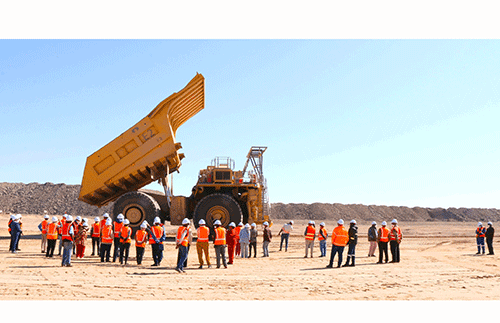SWAKOPMUND – One of the largest uranium producers in Namibia Swakop Uranium has set its eyes on a heap leaching plant that is expected to further boost uranium production.
Heap leaching is a process of extracting valuable minerals, typically metals like gold, copper or uranium, from low-grade ores.
It is an efficient and cost-effective method of extracting minerals that would otherwise be uneconomical to mine, using traditional methods.
In the heap leaching process, large heaps or piles of crushed ore are constructed on an impermeable pad (usually made of plastic or clay) at ground level. The crushed ore is spread over the pad, and a weak cyanide, sulfuric acid or other suitable chemical solution is sprayed or trickled over the ore heap.
Swakop Uranium executive vice president Irvinne Simataa yesterday revealed the mining giant is expecting to spend N$290 million for the construction of a pilot heap leach plant.
“This is to explore the economic feasibility of processing lower-grade uranium ore. Heap leach pilot plant tests will be concluded by the end of 2025, after which further investment will be made to expand to a commercial heap leach plant if found to be economically feasible,” Simataa said in a statement yesterday.
According to him, the company already directly invested over N$6.5 billion in stripping costs through the development of its open pit pushbacks.
Moreover, it has further spent N$81 million on various equipment acquisition and resource development projects.
“Hence, the said investment into the pit expansions and heap leach pilot is meant to secure ore reserves for future processing in the plant and support the lifespan of the mine,” he said.
Increased production
According to the statement, the mine has reported a 10% increase in uranium production during the first quarter of the year.
A total of 2 426 tonnes was produced during the period, representing a 45% increase, compared to the same period in 2022.
The impressive production figures shared by the mine are attributed to the positive growth of strong mining and milling performance year to date.
According to the statement the 2023 half-year mining and milling volumes saw a 29.6% and 20.2% increase, respectively, compared to the same period in 2022.
Simataa also indicated that uranium production is expected to meet and exceed budget production guidance, and that Swakop Uranium is confident to achieve and exceed benchmark reliabilities of assets to sustain current performance.
“This is because while achieving production volumes safely appears to be on a solid foundation, the emphasis remains on cost prudence in areas such as water, electricity, unplanned maintenance, accelerated implementation of plans to mitigate the adverse impact of water supply challenges typically experienced in H2, as well as the successful execution of multi-million-dollar maintenance plans on both plant and mining equipment,” he explained.
According to him, this performance is an incredible feat for the company, and they remain focused on sustaining it for the foreseeable future for further performance and lessons.
Swakop Uranium is a Namibian registered mining company, jointly owned by the Namibian
government through the Epangelo Mining and the Chinese government through the
China General Nuclear Power Corporation and the China-Africa Development Fund.
The construction of the Husab Mine was completed in 2016 at the cost of US$5 billion, the
largest investment in Africa by China.
The Husab Mine boasts a total uranium resource of over 311 000 tonnes of U3O8 (Uranium Oxide), ranking it third in the world by resources and second by production.
The lifespan of the mine is estimated at 20 years.


